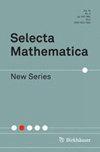Calogero-Moser空间的计算方面
IF 1.2
2区 数学
Q1 MATHEMATICS
引用次数: 2
摘要
摘要给出了一系列计算Calogero-Moser空间和与复反射群相关的有理Cherednik代数的几何不变量和表示论不变量的算法。特别地,我们关注Calogero-Moser族(对应于Calogero-Moser空间的$$\mathbb {C}^\times $$ C x不动点)和元胞特征(由Rouquier和Lusztig基于Calogero-Moser空间的伽罗瓦覆盖的可构造特征的第一作者提出的推广)。为了计算前者,我们设计了一种算法来确定理性Cherednik代数中心的生成器(该算法有几个进一步的应用),为了计算后者,我们开发了一种通过Gaudin算子构建细胞特征的算法方法。我们已经在第二作者的Cherednik代数岩浆包中实现了我们所有的算法,并使用它来确认几个新情况下的开放猜想。作为双几何中的一个有趣的应用,我们能够确定许多特殊的复杂反射群的$$\mathbb {Q}$$ Q -factorial终端的可动锥的腔室分解(从而确定相关辛奇点的非同构相对最小模型的数量)。使这些计算成为可能也是第一作者提出关于Calogero-Moser空间几何(上同调,不动点,辛叶)的几个猜想的灵感来源,这些猜想通常与有限约化群的表示理论有关。本文章由计算机程序翻译,如有差异,请以英文原文为准。

Computational aspects of Calogero–Moser spaces
Abstract We present a series of algorithms for computing geometric and representation-theoretic invariants of Calogero–Moser spaces and rational Cherednik algebras associated with complex reflection groups. In particular, we are concerned with Calogero–Moser families (which correspond to the $$\mathbb {C}^\times $$ C × -fixed points of the Calogero–Moser space) and cellular characters (a proposed generalization by Rouquier and the first author of Lusztig’s constructible characters based on a Galois covering of the Calogero–Moser space). To compute the former, we devised an algorithm for determining generators of the center of the rational Cherednik algebra (this algorithm has several further applications), and to compute the latter we developed an algorithmic approach to the construction of cellular characters via Gaudin operators. We have implemented all our algorithms in the Cherednik Algebra Magma Package by the second author and used this to confirm open conjectures in several new cases. As an interesting application in birational geometry we are able to determine for many exceptional complex reflection groups the chamber decomposition of the movable cone of a $$\mathbb {Q}$$ Q -factorial terminalization (and thus the number of non-isomorphic relative minimal models) of the associated symplectic singularity. Making possible these computations was also a source of inspiration for the first author to propose several conjectures about the geometry of Calogero–Moser spaces (cohomology, fixed points, symplectic leaves), often in relation with the representation theory of finite reductive groups.
求助全文
通过发布文献求助,成功后即可免费获取论文全文。
去求助
来源期刊
CiteScore
2.30
自引率
7.10%
发文量
68
审稿时长
>12 weeks
期刊介绍:
Selecta Mathematica, New Series is a peer-reviewed journal addressed to a wide mathematical audience. It accepts well-written high quality papers in all areas of pure mathematics, and selected areas of applied mathematics. The journal especially encourages submission of papers which have the potential of opening new perspectives.

 求助内容:
求助内容: 应助结果提醒方式:
应助结果提醒方式:


